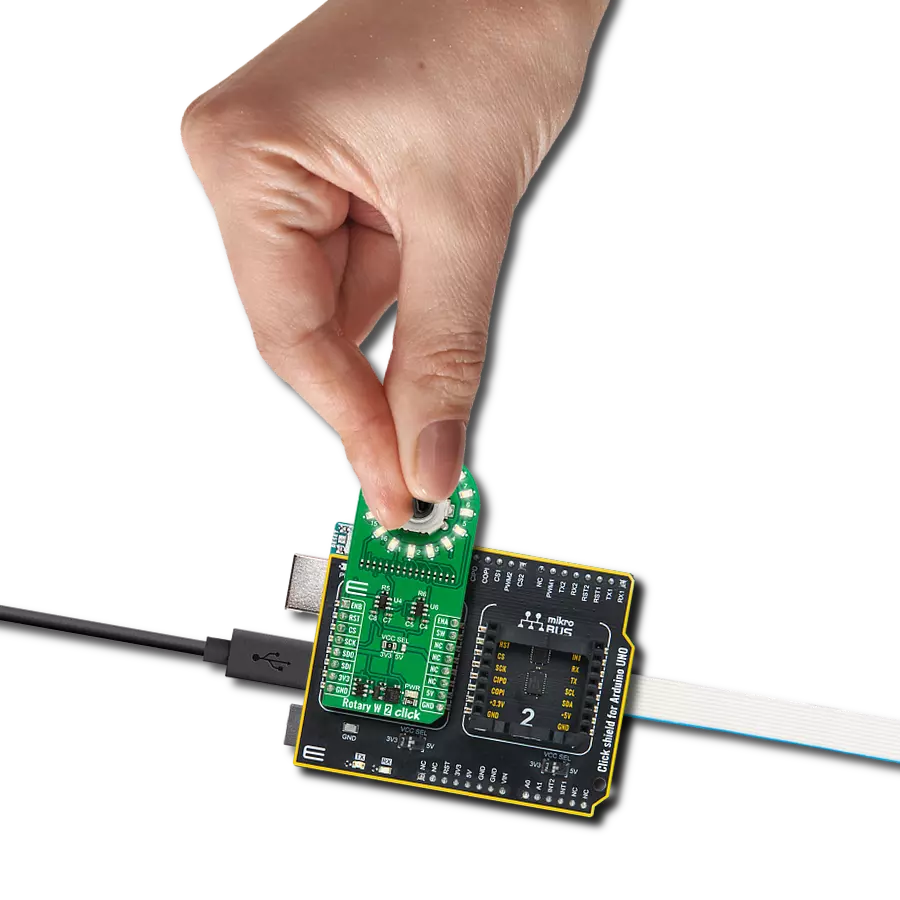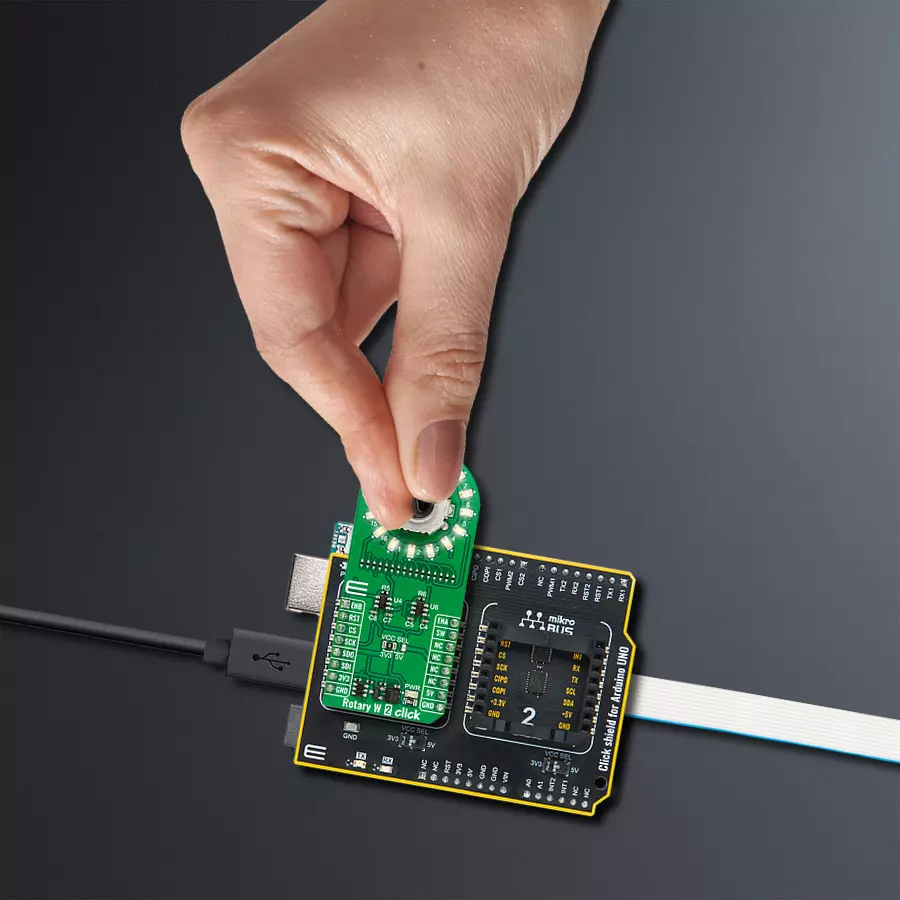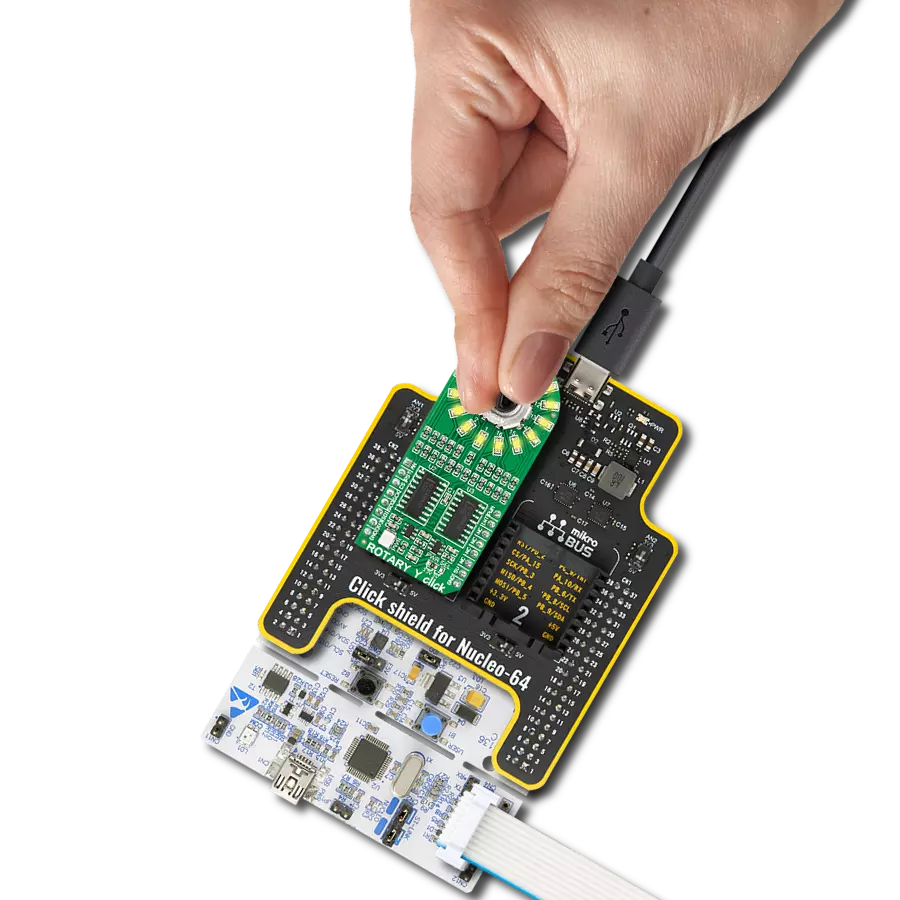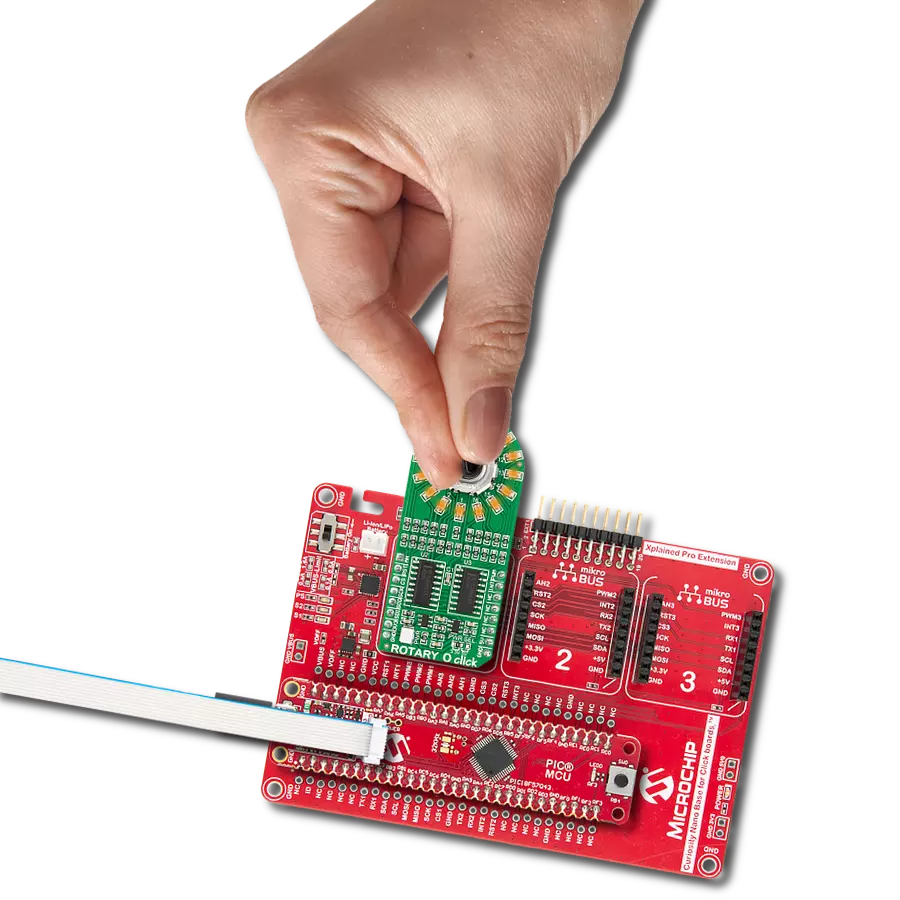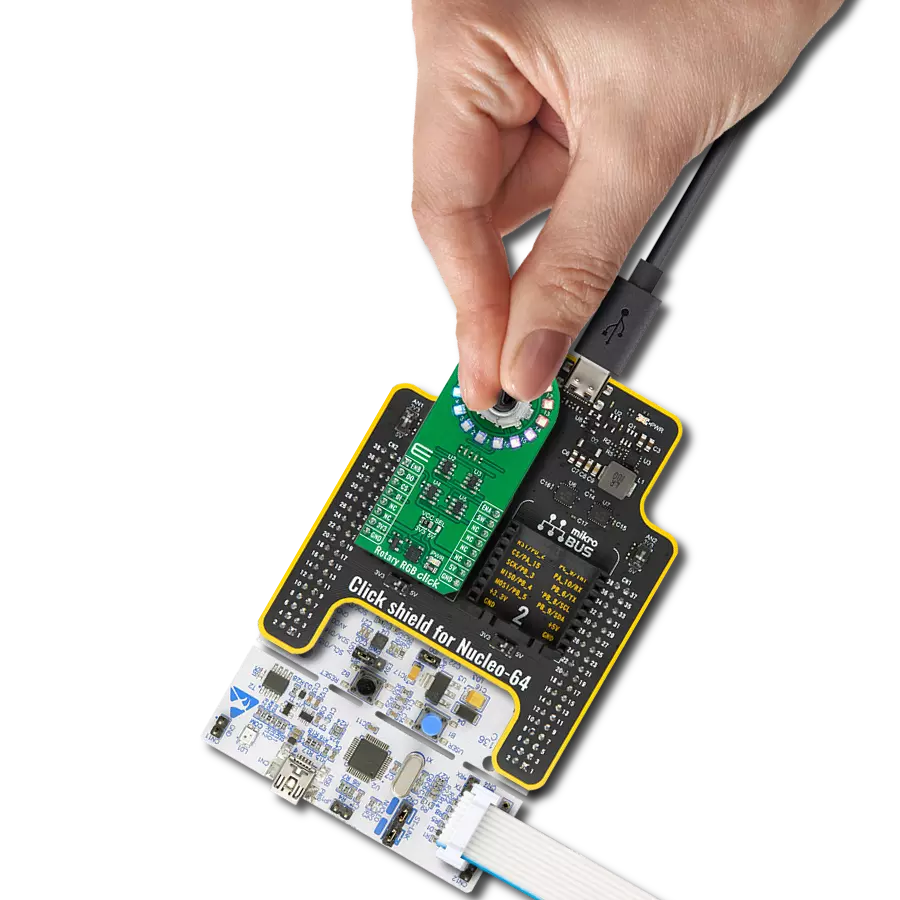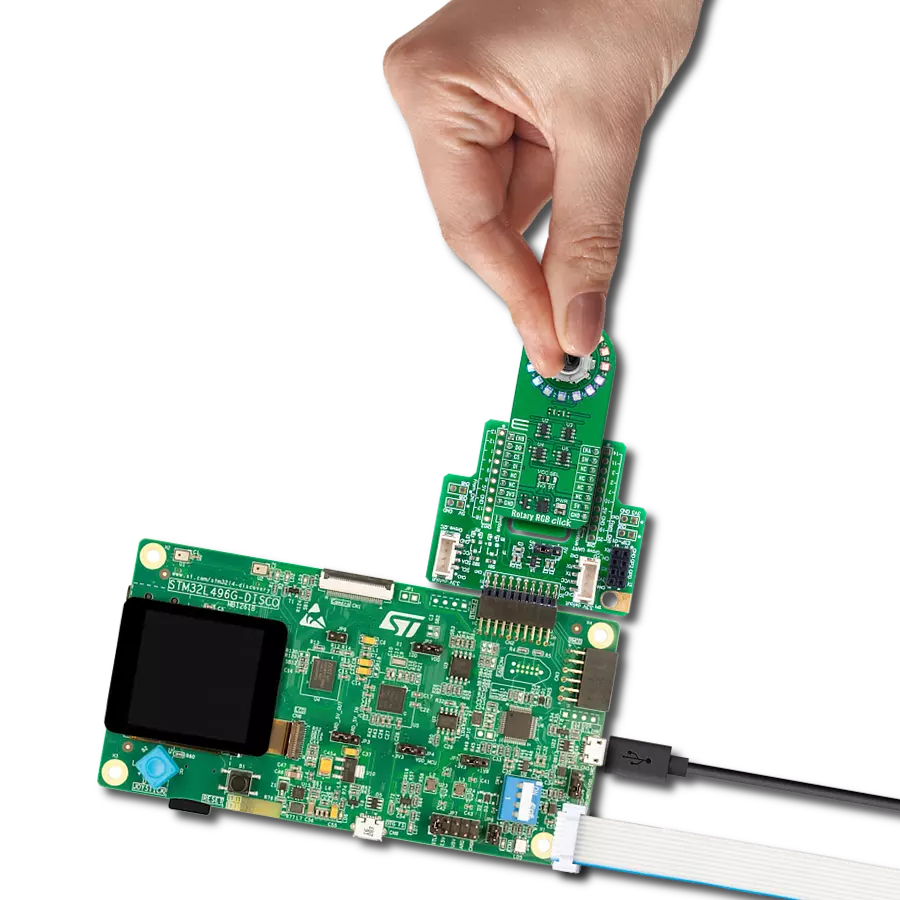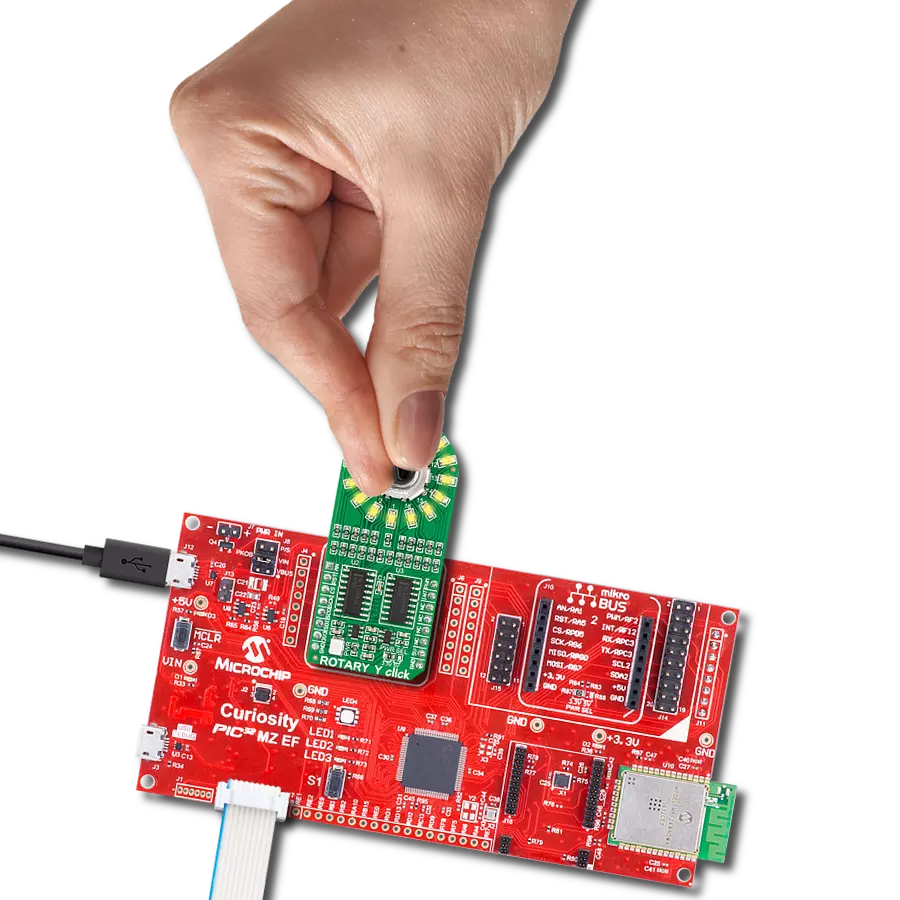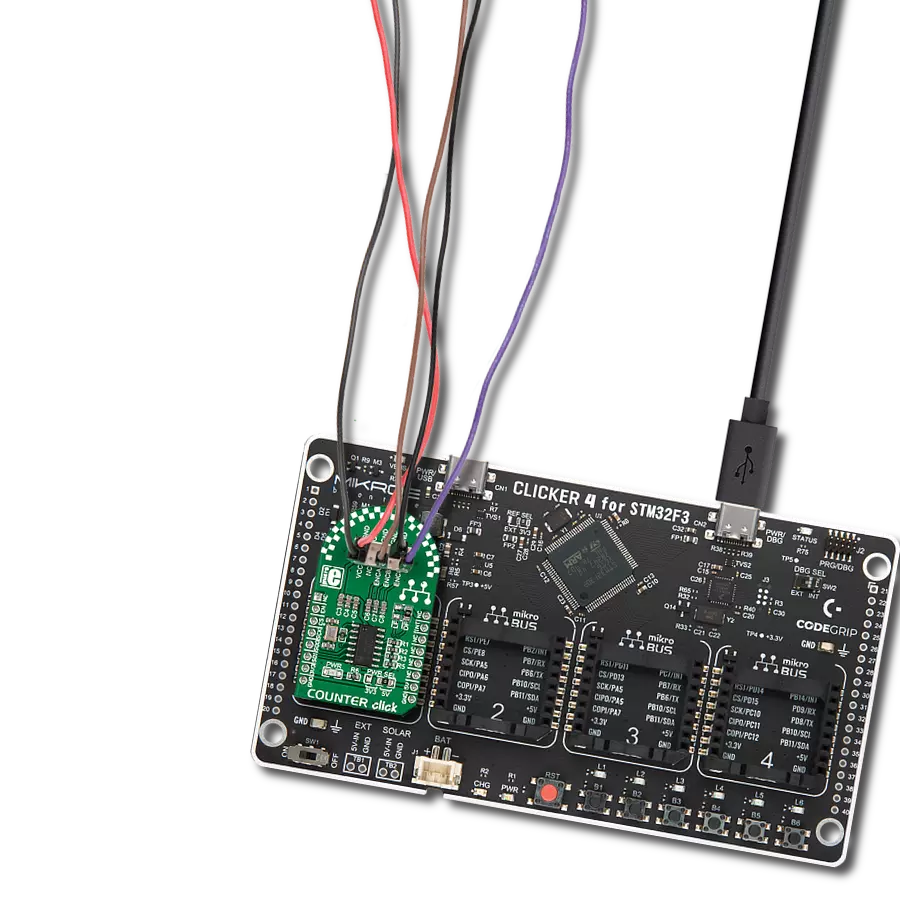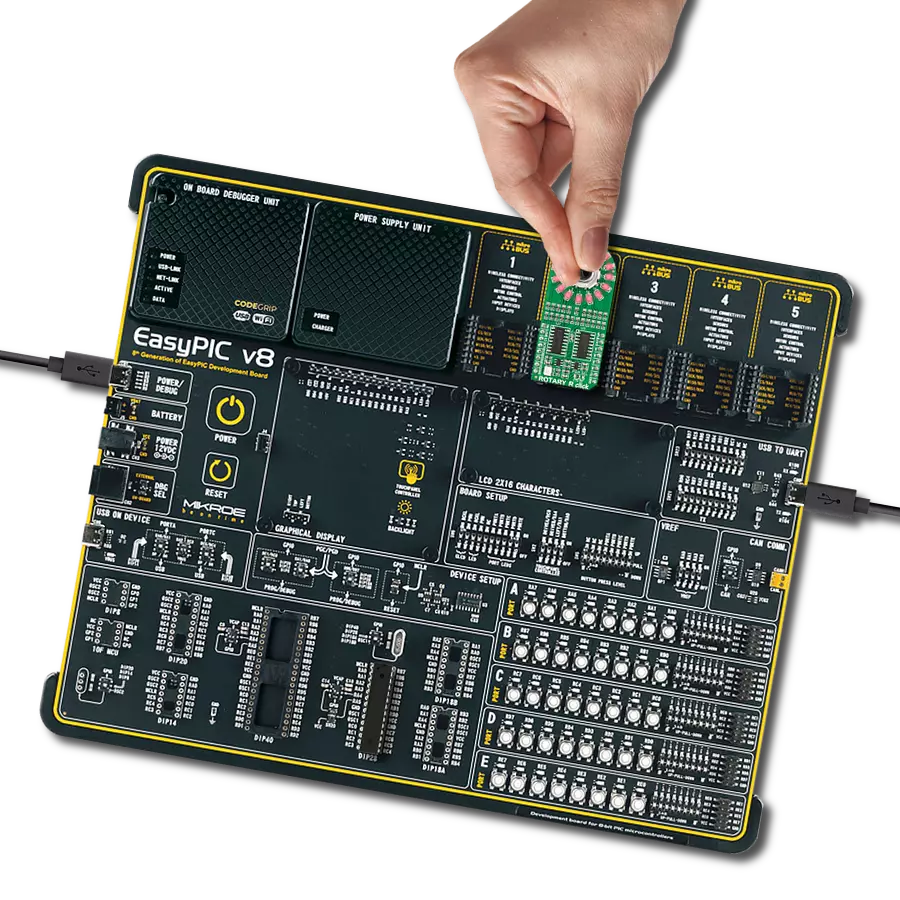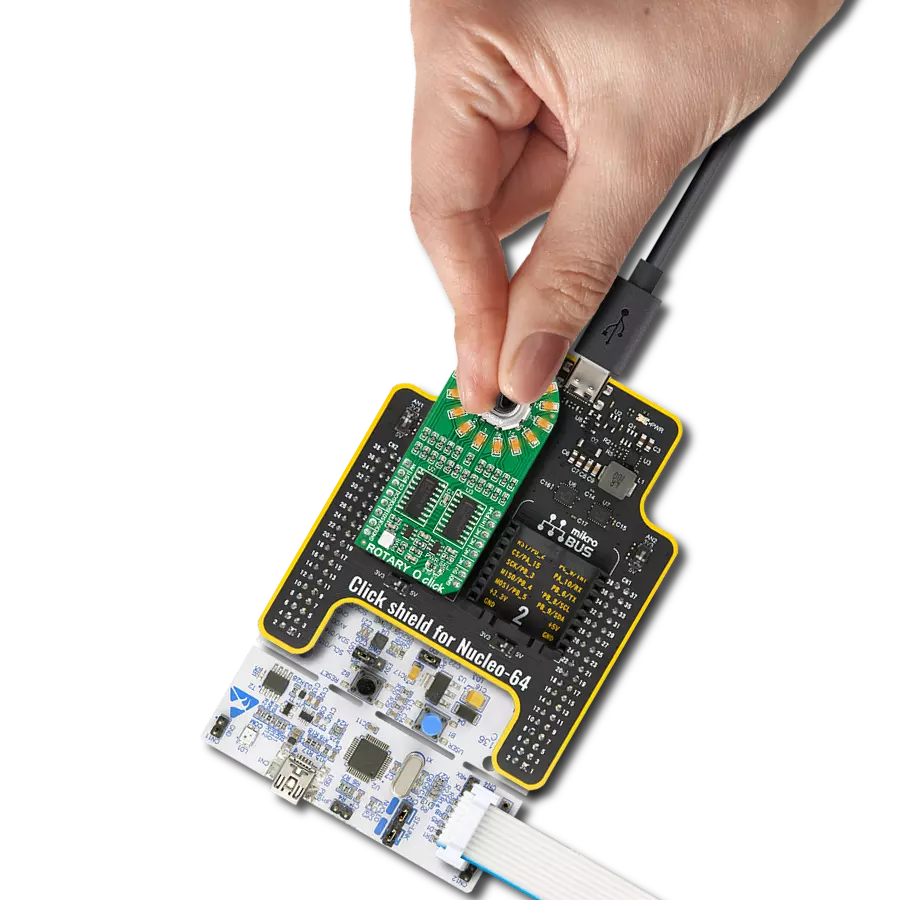通过提供一个带有16个白色LED环的精密输入旋钮,并提供视觉反馈,来增强电子设计。
A
A
硬件概览
它是如何工作的?
Rotary W 2 Click基于德州仪器的TLC5925,这是一款低功率的16通道恒流LED沉降驱动器,结合了来自ALPS的高品质旋转编码器EC12D1564402,使您能够在设计中添加一个精密的输入旋钮。EC12D1564402增量旋转编码器被16个绿色LED环所包围,其中一个单独的旋转被分成15个离散步骤(与电位器相反,旋转编码器可以连续旋转)。驱动器可以单独控制每个LED,允许编程各种照明效果。编码器在两个mikroBUS™线上输出A和B信号(相位
差),同时旋钮按钮特性通过中断线输出。EC12D1564402是一个带有按钮的15脉冲增量旋转编码器。该编码器具有独特的机械规格(其内部开关的去抖时间为2ms),并且可以承受大量的切换周期,高达30,000次。支持去抖动电路允许接触在输出完全触发之前稳定下来。Rotary W 2 Click使用TLC5925 LED驱动器的标准4线SPI串行接口与主机MCU通信,支持最高30MHz的时钟频率。旋转编码器旋转时,在两个mikroBUS™线,即mikroBUS™
插座的ENA和ENB引脚上输出A和B信号(相位差),同时通过SW引脚(中断线)输出按钮接触。使用两个德州仪器的SN74LVC1T45单位双供电总线收发器进行逻辑电平转换。此Click板™可以通过VCC SEL跳线选择3.3V或5V逻辑电压电平。这样,既能使用3.3V又能使用5V的MCU都可以正确使用通信线路。此外,此Click板™配备了一个包含易于使用的函数和示例代码的库,可用作进一步开发的参考。
功能概述
开发板
Arduino UNO 是围绕 ATmega328P 芯片构建的多功能微控制器板。它为各种项目提供了广泛的连接选项,具有 14 个数字输入/输出引脚,其中六个支持 PWM 输出,以及六个模拟输入。其核心组件包括一个 16MHz 的陶瓷谐振器、一个 USB 连接器、一个电
源插孔、一个 ICSP 头和一个复位按钮,提供了为板 子供电和编程所需的一切。UNO 可以通过 USB 连接到计算机,也可以通过 AC-to-DC 适配器或电池供电。作为第一个 USB Arduino 板,它成为 Arduino 平台的基准,"Uno" 符号化其作为系列首款产品的地
位。这个名称选择,意为意大利语中的 "一",是为了 纪念 Arduino Software(IDE)1.0 的推出。最初与 Arduino Software(IDE)版本1.0 同时推出,Uno 自此成为后续 Arduino 发布的基础模型,体现了该平台的演进。
微控制器概述
MCU卡片 / MCU
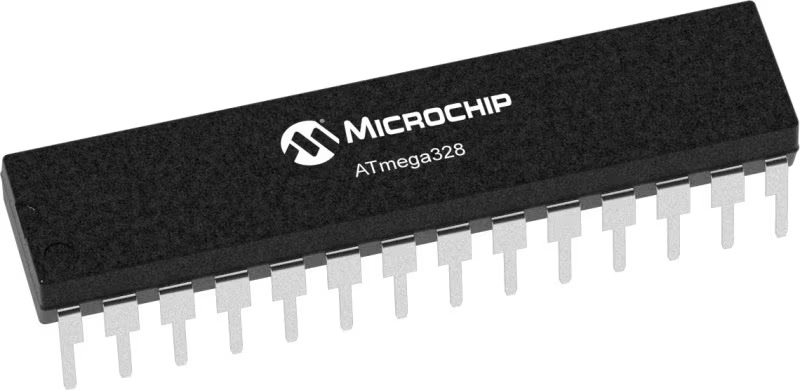
建筑
AVR
MCU 内存 (KB)
32
硅供应商
Microchip
引脚数
32
RAM (字节)
2048
你完善了我!
配件
Click Shield for Arduino UNO 具有两个专有的 mikroBUS™ 插座,使所有 Click board™ 设备能够轻松与 Arduino UNO 板进行接口连接。Arduino UNO 是一款基于 ATmega328P 的微控制器开发板,为用户提供了一种经济实惠且灵活的方式来测试新概念并构建基于 ATmega328P 微控制器的原型系统,结合了性能、功耗和功能的多种配置选择。Arduino UNO 具有 14 个数字输入/输出引脚(其中 6 个可用作 PWM 输出)、6 个模拟输入、16 MHz 陶瓷谐振器(CSTCE16M0V53-R0)、USB 接口、电源插座、ICSP 头和复位按钮。大多数 ATmega328P 微控制器的引脚都连接到开发板左右两侧的 IO 引脚,然后再连接到两个 mikroBUS™ 插座。这款 Click Shield 还配备了多个开关,可执行各种功能,例如选择 mikroBUS™ 插座上模拟信号的逻辑电平,以及选择 mikroBUS™ 插座本身的逻辑电压电平。此外,用户还可以通过现有的双向电平转换电压转换器使用任何 Click board™,无论 Click board™ 运行在 3.3V 还是 5V 逻辑电压电平。一旦将 Arduino UNO 板与 Click Shield for Arduino UNO 连接,用户即可访问数百种 Click board™,并兼容 3.3V 或 5V 逻辑电压电平的设备。
使用的MCU引脚
mikroBUS™映射器
“仔细看看!”
Click board™ 原理图
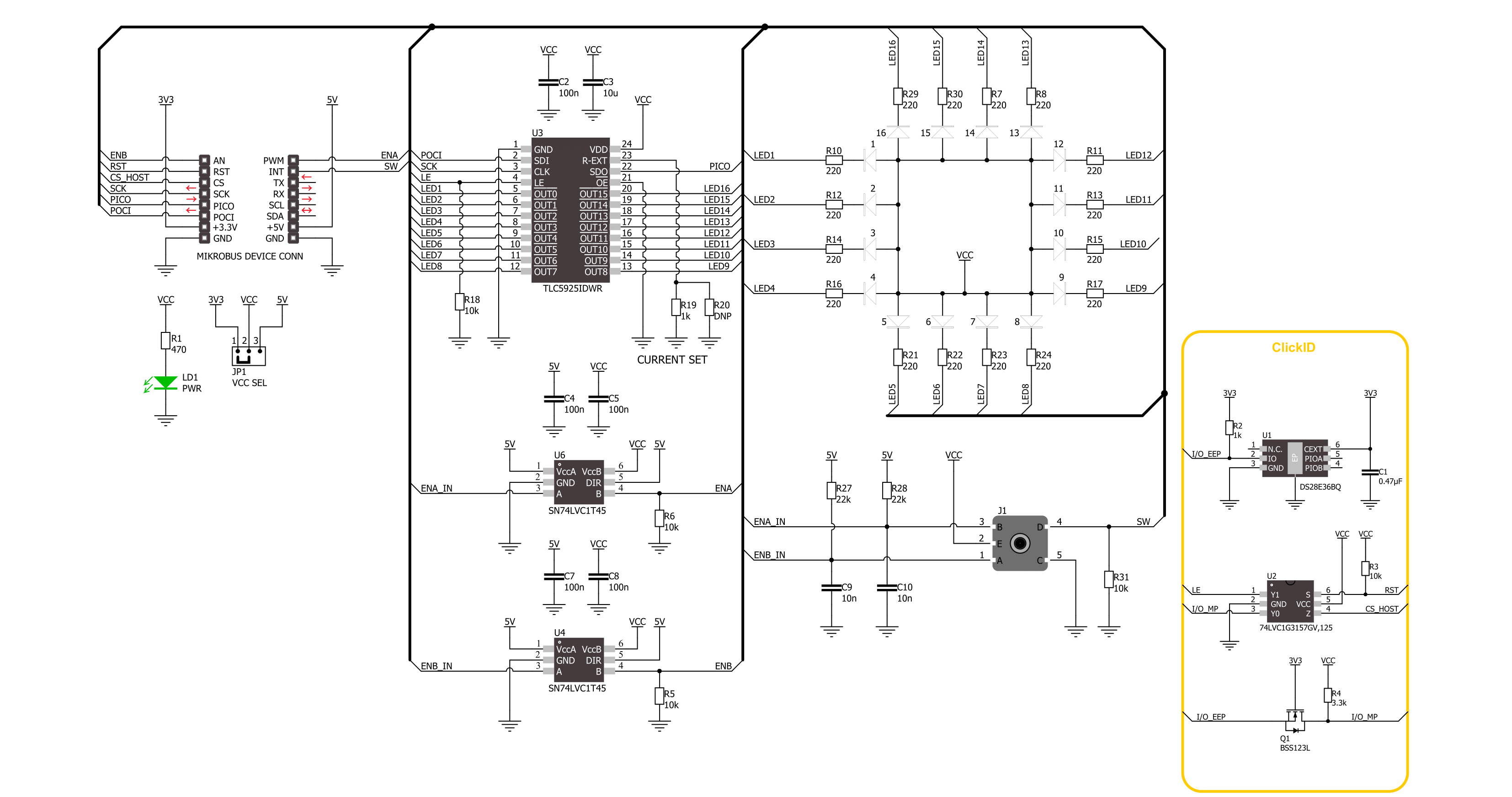
一步一步来
项目组装
软件支持
库描述
该库包含 Rotary W 2 Click 驱动程序的 API。
关键功能:
rotaryw2_set_led_pos- 设置Rotary W 2 LED位置的函数。rotaryw2_set_led_data- 设置Rotary W 2 LED数据的函数。rotaryw2_get_state_switch- 获取Rotary W 2开关状态的函数。
开源
代码示例
完整的应用程序代码和一个现成的项目可以通过NECTO Studio包管理器直接安装到NECTO Studio。 应用程序代码也可以在MIKROE的GitHub账户中找到。
/*!
* @file main.c
* @brief Rotary W 2 Click example
*
* # Description
* This library contains the API for the Rotary W 2 Click driver
* to control LEDs states and a rotary encoder position readings.
*
* The demo application is composed of two sections :
*
* ## Application Init
* Initialization of SPI module and log UART.
* After the driver init, the app executes a default configuration and turn off all LEDs.
*
* ## Application Task
* This example demonstrates the use of the Rotary W 2 Click board™.
* The demo example shows the functionality of a rotary encoder used to control LEDs.
*
* @author Nenad Filipovic
*
*/
#include "board.h"
#include "log.h"
#include "rotaryw2.h"
#define ROTARYW2_ONE_LED ROTARYW2_SET_LED_DATA_1
#define ROTARYW2_TWO_LED ROTARYW2_SET_LED_DATA_1 | ROTARYW2_SET_LED_DATA_9
#define ROTARYW2_FOUR_LED ROTARYW2_SET_LED_DATA_1 | ROTARYW2_SET_LED_DATA_5 | \
ROTARYW2_SET_LED_DATA_9 | ROTARYW2_SET_LED_DATA_13
#define ROTARYW2_EIGHT_LED ROTARYW2_SET_LED_DATA_1 | ROTARYW2_SET_LED_DATA_3 | \
ROTARYW2_SET_LED_DATA_5 | ROTARYW2_SET_LED_DATA_7 | \
ROTARYW2_SET_LED_DATA_9 | ROTARYW2_SET_LED_DATA_11 | \
ROTARYW2_SET_LED_DATA_13 | ROTARYW2_SET_LED_DATA_15
#define ROTARYW2_EIGHT_LED_INV ROTARYW2_SET_LED_DATA_2 | ROTARYW2_SET_LED_DATA_4 | \
ROTARYW2_SET_LED_DATA_6 | ROTARYW2_SET_LED_DATA_8 | \
ROTARYW2_SET_LED_DATA_10 | ROTARYW2_SET_LED_DATA_12 | \
ROTARYW2_SET_LED_DATA_14 | ROTARYW2_SET_LED_DATA_16
static rotaryw2_t rotaryw2;
static log_t logger;
static uint8_t start_rot_status = 0;
static uint8_t led_demo_state = 0;
static uint8_t old_state = 0;
static uint8_t new_state = 1;
static uint8_t old_rot_state = 0;
static uint8_t new_rot_state = 1;
static uint16_t led_data = 1;
/**
* @brief Rotary W 2 select LED demo data function.
* @details This function selects one of the four LED demo data
* based on the current state of the LED demo.
* @return LED demo data:
* @li @c 0x0001 (ROTARYW2_ONE_LED) - Turn ON LED[1],
* @li @c 0x0101 (ROTARYW2_TWO_LED) - Turn ON LED[1,9],
* @li @c 0x0101 (ROTARYW2_FOUR_LED) - Turn ON LED[1,5,9,13],
* @li @c 0x5555 (ROTARYW2_EIGHT_LED) - Turn ON LED[1,3,5,7,9,11,13,15].
*/
static uint16_t rotaryw2_sel_led_demo_data ( uint8_t led_demo_state );
/**
* @brief Rotary W 2 switch detection function.
* @details This function is used for the switch state detection.
* @return Nothing.
*/
static void rotaryw2_switch_detection ( void );
/**
* @brief Rotary W 2 encoder mechanism function.
* @details This function is used to control the state of the LEDs
* by detecting the rotation direction of the rotary encoder.
* @return Nothing.
*/
static void rotaryw2_encoder_mechanism ( void );
void application_init ( void )
{
log_cfg_t log_cfg; /**< Logger config object. */
rotaryw2_cfg_t rotaryw2_cfg; /**< Click config object. */
/**
* Logger initialization.
* Default baud rate: 115200
* Default log level: LOG_LEVEL_DEBUG
* @note If USB_UART_RX and USB_UART_TX
* are defined as HAL_PIN_NC, you will
* need to define them manually for log to work.
* See @b LOG_MAP_USB_UART macro definition for detailed explanation.
*/
LOG_MAP_USB_UART( log_cfg );
log_init( &logger, &log_cfg );
log_info( &logger, " Application Init " );
// Click initialization.
rotaryw2_cfg_setup( &rotaryw2_cfg );
ROTARYW2_MAP_MIKROBUS( rotaryw2_cfg, MIKROBUS_1 );
if ( SPI_MASTER_ERROR == rotaryw2_init( &rotaryw2, &rotaryw2_cfg ) )
{
log_error( &logger, " Communication init." );
for ( ; ; );
}
if ( ROTARYW2_ERROR == rotaryw2_default_cfg ( &rotaryw2 ) )
{
log_error( &logger, " Default configuration." );
for ( ; ; );
}
log_info( &logger, " Application Task " );
}
void application_task ( void )
{
if ( ROTARYW2_OK == rotaryw2_set_led_data( &rotaryw2, led_data ) )
{
rotaryw2_switch_detection( );
rotaryw2_encoder_mechanism( );
}
}
int main ( void )
{
/* Do not remove this line or clock might not be set correctly. */
#ifdef PREINIT_SUPPORTED
preinit();
#endif
application_init( );
for ( ; ; )
{
application_task( );
}
return 0;
}
static uint16_t rotaryw2_sel_led_demo_data ( uint8_t led_demo_state )
{
switch ( led_demo_state )
{
case 0:
{
return ROTARYW2_ONE_LED;
break;
}
case 1:
{
return ROTARYW2_TWO_LED;
break;
}
case 2:
{
return ROTARYW2_FOUR_LED;
break;
}
case 3:
{
return ROTARYW2_EIGHT_LED;
break;
}
default:
{
return ROTARYW2_ONE_LED;
break;
}
}
}
static void rotaryw2_switch_detection ( void )
{
if ( rotaryw2_get_state_switch( &rotaryw2 ) )
{
new_state = 1;
if ( ( 1 == new_state ) && ( 0 == old_state ) )
{
old_state = 1;
led_demo_state = ( led_demo_state + 1 ) % 5;
if ( 4 == led_demo_state )
{
for ( uint8_t n_cnt = 0; n_cnt < 10; n_cnt++ )
{
rotaryw2_set_led_data( &rotaryw2, ROTARYW2_EIGHT_LED_INV );
Delay_ms ( 100 );
rotaryw2_set_led_data( &rotaryw2, ROTARYW2_EIGHT_LED );
Delay_ms ( 100 );
}
for ( uint8_t led_p = ROTARYW2_SET_LED_POS_1; led_p <= ROTARYW2_SET_LED_POS_16; led_p++ )
{
rotaryw2_set_led_pos( &rotaryw2, led_p );
Delay_ms ( 100 );
}
led_demo_state = 0;
led_data = rotaryw2_sel_led_demo_data( led_demo_state );
}
else
{
led_data = rotaryw2_sel_led_demo_data( led_demo_state );
}
}
}
else
{
old_state = 0;
}
}
static void rotaryw2_encoder_mechanism ( void )
{
if ( rotaryw2_get_state_ena( &rotaryw2 ) == rotaryw2_get_state_enb( &rotaryw2 ) )
{
old_rot_state = 0;
start_rot_status = rotaryw2_get_state_ena( &rotaryw2 ) && rotaryw2_get_state_enb( &rotaryw2 );
}
else
{
new_rot_state = 1;
if ( new_rot_state != old_rot_state )
{
old_rot_state = 1;
if ( start_rot_status != rotaryw2_get_state_ena( &rotaryw2 ) )
{
led_data = ( led_data << 1 ) | ( led_data >> 15 );
}
else
{
led_data = ( led_data >> 1 ) | ( led_data << 15 );
}
}
}
}
// ------------------------------------------------------------------------ END
额外支持
资源
类别:旋转编码器
